
 Jon Zella
The Hockey Writers
Jon Zella
The Hockey Writers
39
Reads
0
Comments
Top 10 Worst Mike Milbury Moves
Mike Milbury has long been a flamboyant and interesting figure in the NHL. From his time as a player, when he jumped into the MSG stands and beat a fan with his own shoe, to his current role as an NBC Sports analyst, where his comments have often gotten him into hot water, Milbury always seems to find his way into the headlines. (from ‘Over the Glass and Into Hockey Lore, New York Times, 12/12/2009) His attention-grabbing acts weren’t limited to a player or as an analyst.
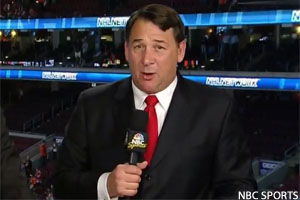
After a successful two-year run as head coach of the Boston Bruins, he joined the New York Islanders in 1995 as their head coach and, within a few months, was their general manager (GM). But you don’t need to remind Islander fans of a certain age.
Even though he, along with owners Charles Wang and Sanjay Kumar, helped the Islanders get back to the playoffs in the early 2000s, the team was constantly put in a bad position due to Milbury’s tinkering. Here’s a look at some of Mad Mike Milbury’s worst transactions from the late ’90s to the mid-2000s.
Related: Every Stanley Cup Winner Since 1960
10.) Traded J.P Dumont & 5th-Round Selection (1998) for Dmitri Nabokov
Jean-Pierre Dumont, the Islanders’ first-round (3rd-overall) pick in the 1996 NHL Draft never suited up for the blue and orange. He went on to have a lengthy career with the Chicago Blackhawks, Buffalo Sabres, and Nashville Predators with six 20-goal seasons and five seasons of 50 or more points, good for sixth-most of those drafted in ’96.
Dmitri Nabokov was a high-scoring forward for the Regina Pats during the 1996-97 season who was drafted by the Blackhawks 19th overall in the 1995 draft. He registered just 13 points in 30 career games for the New York Islanders. After bouncing around the NHL and AHL for a few years, he took his services to Europe, where he continued to play until 2010-11. Sadly, Nabokov passed away in 2019.
9.) Traded Chris Osgood & 3rd-Round Selection (2003) to St. Louis Blues for Justin Papineau and 2nd-Round Selection (Jeremy Colliton)
Acquired during the waiver draft in September 2001, the Islanders seemed to have solved their goaltending problem — at least in the short term —with Chris Osgood. (from ‘OSGOOD SWIFTLY MAKES ISLANDERS A CONTENDER,’ Florida Sun-Sentinel, 9/30/2001) Along with Alexei Yashin and Michael Peca, Osgood helped bring the Islanders back to the playoffs. But like many of the team’s pick-ups in the early 2000s, they were short-lived. Despite winning 49 of 103 games with the Islanders, Osgood was shipped to the St. Louis Blues just as the Islanders started making the playoffs again. While Rick DiPietro started to find his way in the NHL, a one-two punch of Osgood and DiPietro may have helped the team’s chances in the playoffs.
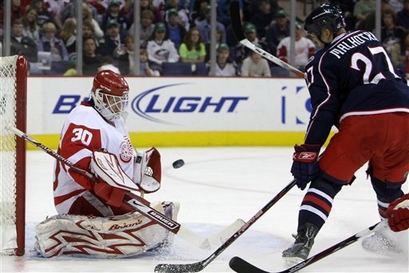
As for the return, Justin Papineau spent time shuffling back and forth between the Bridgeport Sound Tigers of the AHL and the Islanders, but he never developed. Some initially argued that the bigger piece in this trade was the second-round selection that turned out to be Jeremy Colliton, but he too never quite panned out.
8.) Drafting Robert Nilsson 15th Overall in the 2003 NHL Draft
In what some call one of the deepest drafts ever, Milbury chose Robert Nilsson 15th overall in the 2003 NHL Draft. It’s bad enough that a first-round selection only played 53 games for the team, but it’s another thing entirely to look back at the players Milbury — and a host of other GMs — looked over.
Related: Hockey 101 – A Beginner’s Guide to Ice Hockey
Players like Dustin Brown, Ryan Kessler, Zach Parise, and Corey Perry were still available. All of those players went on to have amazing careers, many of whom won Stanley Cups, while Nilsson scored 118 points in 252 games before heading to Europe in 2010, ending his NHL career.
7.) Drafted Rick DiPietro with #1 Overall Pick at 2000 NHL Entry Draft
Like Milbury, Rick DiPietro will forever be a lightning rod for critics. Without getting into the weeds too much on his career, his injuries and contract truly aren’t the issues with this pick. Leading up to this draft, Milbury did quite a bit of wheeling and dealing, even for his standards. Some of those deals are on this list and played a role in either landing or setting the team up for the first-overall pick. In another situation, this may have worked out, but there are two reasons this was a poor move by Milbury outside of DiPietro’s career.
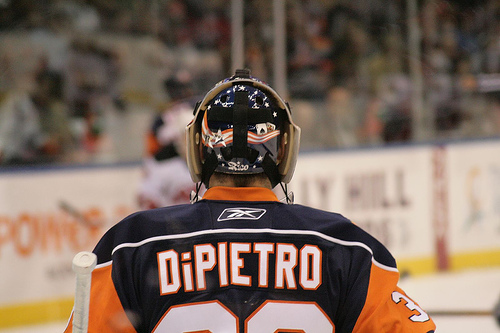
First, there’s something to be said about taking the best player available in the draft or taking a player that you believe can be the cornerstone talent for your franchise. Any way you can improve your team should be taken advantage of, whether that’s short term or long term. However, when you already have a player in that position — in this case, goaltender Roberto Luongo — showing promise on an objectively mediocre team, trading away assets to get that player in what turned out to be a deep draft seems, and turned out to be, unwise.
“We’re rolling the dice here a little bit,” said Milbury, in a giant understatement. “Roberto Luongo is going to be an excellent goaltender. He is a class act and a kid that we would have been happy to ride with. But as the draft progressed, it was clear that the value of Luongo was greater than the value of the first overall pick.”
In short, this quote did not age well. While DiPietro was an NHL All-Star, Olympian for Team USA, and, simply, a pretty good goalie when he wasn’t injured, his numbers and resume can’t touch Luongo’s.
The New York Islanders turned heads during the 2000 NHL Entry Draft, but for the wrong reason(s). Milbury made hockey history when he selected a goalie, DiPietro, with the number one overall. The Islanders had been developing Luongo, but Milbury was convinced that DiPietro would be the future of the franchise.
6.) Traded Bryan Berard & 6th-Round Selection for Felix Potvin & 6th-Round Selection
Even at number five, this one hurts as an Islanders fan. While playing on some awful teams, Bryan Berard managed to win the Calder Trophy in 1997. After just under two and half seasons on Long Island, he was shipped out for Felix Potvin.

The issue with this trade starts with trading a Calder Trophy winner but gets more frustrating to think about when you’re reminded that Potvin played a total of 33 games in the blue and orange. He never did regain his form, though he managed to end his career on a high note, recording 31 and 29 wins respectively in 2001-02 and 2002-03.
Related: Hockey Documentaries to Watch Right Now
The season after he was traded to Toronto, he suffered a gruesome eye injury that changed the trajectory of his career. He managed to bounce back, though that was short-lived as other injuries kept him sidelined following the 2002-03 season. However, things have a way of working out. Whether you call it poetic justice or the circle of life, Berard eventually returned to Long Island to end his career for the 2006-07 season. At the age of 30, he asked the Islanders for a tryout and appeared in an Isles jersey again for the first time in nearly a decade on Oct. 10, 2007. He scored a power play goal in his return.
5.) Traded Bryan McCabe, Todd Bertuzzi & 3rd-Round Selection (Jarko Ruutu) for Trevor Linden
When you think of Bryan McCabe and Todd Bertuzzi on the Islanders, you may nostalgically smile as you remember these young players in the controversial Fisherman jerseys. When that wears off, you remember that Milbury traded them for Trevor Linden at the trade deadline in 1998. The issues with the trade are less about the return and more about what was given up.
Linden only played 107 games for the Islanders before he was traded. His production wasn’t what it used to be and it didn’t help that, aside from Ziggy Palffy, there wasn’t much support for him since Milbury traded any hope of that away (see the rest of this list).
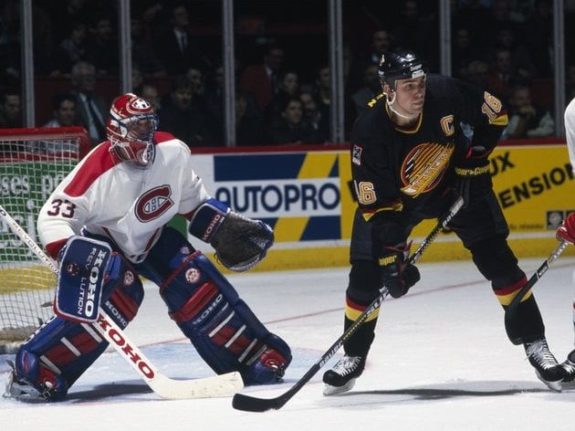
As for the assets shipped out, McCabe flourished in Toronto after his short stay in Vancouver and a cup of coffee with the Blackhawks. Bertuzzi wound up having six-straight seasons (1999 to 2006) of at least 50 points for the Canucks to go along with 30 and 40-goal seasons. Both players could have been important pieces of the Islanders’ resurgence in the early 2000s, but their success played out on other teams while the Islanders searched for players to bring them to the next level.
4.) Traded Zdeno Chara, Bill Muckalt & 1st-Round Selection (Jason Spezza) for Alexei Yashin
Yashin was an important part of the Islanders’ return to the Stanley Cup Playoffs in 2001-02 and, had he helped the team become a real contender or even bring them a Cup, this trade never makes the list. Unfortunately, with the success of the players the Islanders gave up — Zdeno Chara and the first-round selection that became Spezza — this is a tough one to look back on.
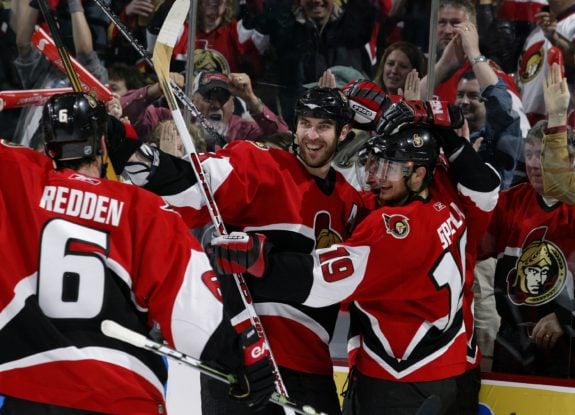
Taking a look back, if teams were to re-draft their selections in 2001, things may look a bit different. A lot of second and third-round picks turned out to be very productive and long-time NHL players. But at the top of the heap, Ilya Kovalchuk and Spezza still go 1-2. The choice between the two would still be tough.
Related: NHL Legend Bill Torrey & His Islanders Legacy
Spezza has outscored Kovalchuk, 940 points to 876, but Kovalchuk has a better points-per-game rate, .94 to .83. Either way, as it stands Spezza is the highest-scoring player in that draft, making this move begin to boil the blood of Islanders fans. What will turn up the heat more is the fact that Spezza outscored Yashin 232 to 150 over the last three seasons of Yashin’s NHL career, all with the Islanders. Not to mention Chara, whose defense has helped his teams make deep playoff runs, not to mention his fairly consistent offensive numbers.
The final nail in the coffin of this trade occurred when Spezza, Chara, and the Senators beat the Islanders in the first round of the 2003 Stanley Cup Playoffs four games to one.
3.) Signed Alexei Yashin to 10-Year, $90M Contract
Until DiPietro’s 15-year contract, Yashin’s 10-year deal worth $87.5 million was one of the league’s largest in NHL history. Milbury believed that Yashin would carry the team for years and at first, it looked like it may work out. He came to the Islanders with four-straight, 30-plus goal seasons, including back-to-back, 40-plus goal campaigns in the seasons prior to his arrival on Long Island. In his first season with the Islanders, he scored 32 goals and 75 points in 78 games, leading the team in points by a healthy margin and helped the Islanders earn their first playoff berth in nearly a decade.
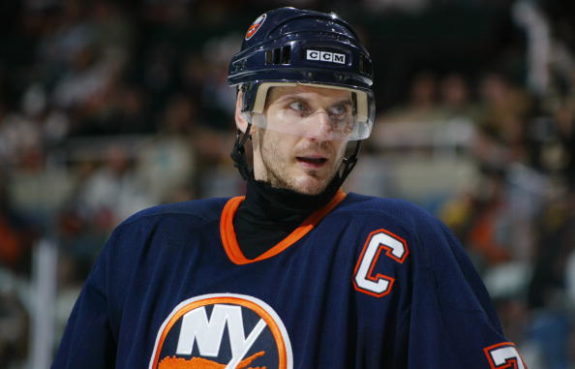
The following two seasons, while Yashin’s production declined, the Islanders made the playoffs, though they continued to lose in the first round. During the 2003-04 season, he suffered a laceration to his forearm, causing him to miss nearly half the season. He followed that up with a 28-goal performance following the lockout, but the end was coming for Yashin. The next season, he scored 50 points in 58 games, which is respectable, but not for someone making the type of money he was.
With the salary cap forcing teams to make tough decisions, general manager Garth Snow bought out Yashin following the 2006-07 season. Due to the amount remaining on his contract, the Islanders finished paying him during the 2014-15 season, dragging out this terrible deal and Milbury’s influence on the team.
2.) Traded Ziggy Palffy, Marcel Cousineau, Bryan Smolinski, and the 1999 4th-Round Pick (Daniel Johansson) for Mathieu Biron, Josh Green, Olli Jokinen, and the 1999 8th-Overall Pick (Taylor Pyatt)
As if you haven’t gone through enough to this point, now it’s time to revisit the Palffy trade. This is one of the more complicated trades on this list because it can’t be boiled down to Milbury’s incompetence alone. With the Islanders failing to make the playoffs for five-straight seasons, a host of ownership issues, and a building that was falling apart, fans stopped coming to games, putting the team in the basement of the league in points and in spending. That meant the team needed to cut payroll, and Palffy’s five-year, $24 million contract was deemed “expendable.”
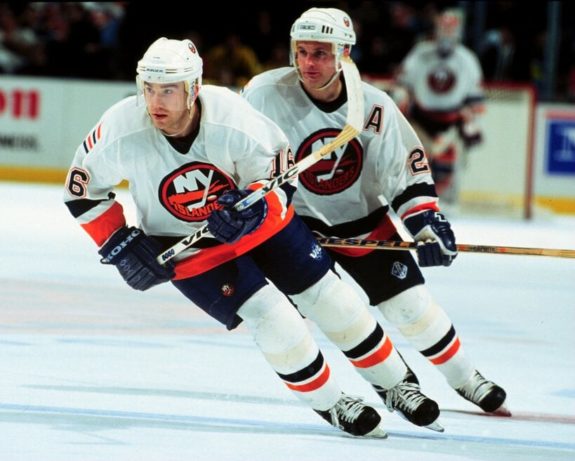
At the direction of then-owners Howard Milstein and Steven Gluckstern, Milbury began trying to find trade partners. After the league vetoed an initial deal with the Los Angeles Kings, Milbury, in an act of heresy, nearly sent Palffy across the East River to Manhattan to play for the rival Rangers. (from ‘RANGERS BACK IN PALFFY MIX: COMMISH VETOES ISLES-KINGS DEAL, New York Post, 06/17/1999) Pressure from above or not, that would have been the most haunting trade in Islanders’ history.
The deal would have sent “Palffy and defenseman Rich Pilon to the New York Rangers for a package that included forwards Todd Harvey and Niklas Sundstrom,” according to an AP report. The deal with the Rangers fell through and talks resumed with the Kings, coming to fruition in late June.
Despite never being able to complete a full season after leaving Long Island due to injuries, Palffy enjoyed an amazing career with the Kings and eventually the Pittsburgh Penguins. In May 2019, he was inducted into the IIHF Hall of Fame.
As for the return for Palffy, the only player of any consequence was Olli Jokinen. Like the deal that sent Berard to the Leafs for Potvin, Jokinen’s time on Long Island was short, making the trade even more head-scratching. He only played one full season for the Islanders before being shipped off in arguably the worst deal during the Milbury era.
1.) Traded Olli Jokinen & Roberto Luongo for Mark Parrish and Oleg Kvasha
Some may say it’s easy, even cheap, to judge a trade years after the players’ careers have played out. Hindsight is 20-20, right? Yes, but some trades play out so poorly that you can’t help but scratch your head and wonder what they were thinking. Enter Milbury’s worst deal with the Islanders where he sent budding stars Roberto Luongo and Olli Jokinen to the Florida Panthers for Oleg Kvasha and Mark Parish.
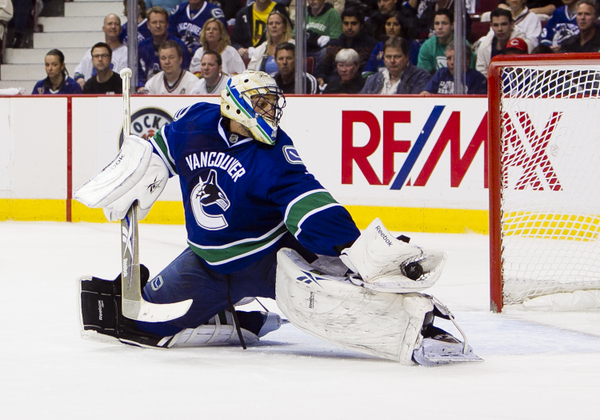
To start, Kvasha wasn’t anything to write home about while he was in Florida and remained, at best, a middle-six forward his entire career. Parish turned out to be a good goal scorer for the Islanders, putting together three-straight, 20-plus goal seasons including a 30-goal campaign his second season on Long Island. The issue is, Jokinen scored 419 points in 567 games for the Panthers between 2000-01 and 2007-08 — that’s nine points less than what Parish and Kvasha scored combined over the same period.
Related: 7 Things About Roberto Luongo
Not to mention Luongo, who, in his first season with the Panthers, played 47 games with a save percentage of .920. Despite his short time on Long Island, he spoke fondly of the beginning of his career. (from ‘A return to his NHL roots on Long Island rekindles memories for Luongo,’ Vancouver Sun, 10/21/2013)
With the exception of a few positive points along the way, the Islanders were plagued with terrible goaltending for years following this trade while Luongo put together a stellar career.
All-Time Traded Team
Hockey fans seem to be some of the more nostalgic people out there and Islander fans are chief among them. In addition, people find a special pride in poking fanbases and their team’s terrible management — an easy task when considering the Isles. Milbury, among a host of other disastrous stories about the franchise from the mid-1990s, made it all too easy for the Islanders to continue to come up in the conversation.
But even fans agree that, based on the list above and a handful of other trades, Milbury could have created one heck of a team. Players like Ziggy Palffy, Bryan Berard, Bryan McCabe, Olli Jokinen, Roberto Luongo, and Todd Bertuzzi all had great careers in the NHL in other uniforms.
When looking back on these revisionist constructions of possible rosters, it’s important to remember that Milbury was the GM before there was a salary cap instituted in the NHL, though the team didn’t exactly have money to burn even after Wang purchased the team. That doesn’t give Milbury a pass, but it’s something we should keep in mind when dissecting these deals. In any event, it’s both fun and (mostly) sad for Isles fan to reminisce about of what could have been.
The post Top 10 Worst Mike Milbury Moves appeared first on The Hockey Writers.
Popular Articles

















































 Blackhawks Chicago
Blackhawks Chicago Panthers Florida
Panthers Florida Penguins Pittsburgh
Penguins Pittsburgh Rangers New York
Rangers New York Avalanche Colorado
Avalanche Colorado Kings Los Angeles
Kings Los Angeles Maple Leafs Toronto
Maple Leafs Toronto Bruins Boston
Bruins Boston Capitals Washington
Capitals Washington Flames Calgary
Flames Calgary Oilers Edmonton
Oilers Edmonton Golden Knights Vegas
Golden Knights Vegas Senators Ottawa
Senators Ottawa Lightning Tampa Bay
Lightning Tampa Bay Flyers Philadelphia
Flyers Philadelphia Islanders New York
Islanders New York Sabres Buffalo
Sabres Buffalo Red Wings Detroit
Red Wings Detroit Devils New Jersey
Devils New Jersey Hurricanes Carolina
Hurricanes Carolina Blue Jackets Columbus
Blue Jackets Columbus Predators Nashville
Predators Nashville Wild Minnesota
Wild Minnesota Blues St. Louis
Blues St. Louis Stars Dallas
Stars Dallas Jets Winnipeg
Jets Winnipeg Mammoth Utah
Mammoth Utah Sharks San Jose
Sharks San Jose Canucks Vancouver
Canucks Vancouver Ducks Anaheim
Ducks Anaheim






